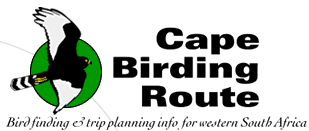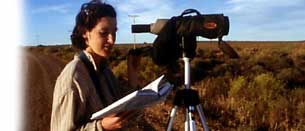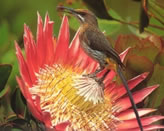Select
Specials: Overberg and South
Coast
Cape Vulture
Depending
on their itinerary, visiting birders touring South Africa
would find it worth their while to attempt to see this species
in the Overberg, despite only about one hundred birds remaining
here. A common fallacy is that this bird is easy to see in
the game reserves in the east of the country, but it is in
fact difficult to find except in the Drakensberg mountains,
in the far Eastern Cape Province, and in the vicinity of breeding
colonies in the Northern Province. The Potberg colony (p.65)
is notable as the last existing in the Fynbos Biome, and currently
consists of just 32 breeding pairs. This species has declined
drastically in South Africa in the past few decades, primarily
due to poisoning from stock carcasses laid out by farmers
to eradicate vermin.
Blue Crane
This
is the country’s national bird, although it escapes being
a true South African endemic by virtue of a small population
on Etosha Pan in northern Namibia. In the Western Cape, the
birds occur fairly scarcely in the wheatfields of the West
Coast’s Swartland region (see p.45), but are common and
easy to find in the Overberg wheatlands. They are especially
conspicuous in winter, when breeding pairs congregate into
large flocks of up to several hundred individuals. Indeed,
this is one of the few rare birds that may have benefited
from the destruction of lowland fynbos in favour of the agriculture
that emulates its grassland habitat. Driving along the N2
national road east of Cape Town, you are bound to see cranes
at the roadside – often close to small farm dams –
even before reaching Caledon or Riviersonderend, and they
may also be seen along the farmland loops described on p.63.
Stanley’s Bustard
Isolated
in the moist grasslands and lowland fynbos of South Africa,
Stanley’s Bustard is currently classified as a subspecies
of Denham’s Bustard, whose range extends into East Africa.
It has adjusted well to the Overberg wheatlands, particularly
those east of Bredasdorp. Though never common, it is readily
seen – refer to the main text for likely sites within
the Bontebok National Park (p.69) and the Overberg farmlands
(p.63). Worth looking out for during spring are the displaying
males, which retract their heads, inflate their white throat
pouches, and strut about in this voluminous state – an
intriguing sight that, from a distance, one might uncharitably
liken to a plastic shopping bag caught in the vegetation.
Knysna Woodpecker
This
unobtrusive and little-known species is globally restricted
to the narrow southern coastal strip of South Africa, extending
as far north as the southern extremity of KwaZulu-Natal. It
is not actually a very rare bird in its preferred habitat
– dense coastal thicket or afromontane forest –
but is rather challenging to see, as it calls only at lengthy
and irregular intervals. The call is a short scream, likened
by many to ‘Skead!’ in honour of one of the
Eastern Cape Province’s great natural historians, C.J.
Skead. Closest to Cape Town, it can be found in the thickets
of the De Hoop Nature Reserve (p.64) and the forests of Grootvadersbosch
Nature Reserve (p.69). Further east, it occurs more commonly
in the Garden Route forests (p.117).
Agulhas Long-billed Lark
This
species is a recent and localized split of Long-billed Lark
(see p.13). It is restricted to the south coast, and is most
common east of Bredasdorp (see Farmland Loops, p.63, for details
of reliable sites). It is especially easy to locate in spring,
when males regularly perform their looping display flights,
launched from roadside fence posts and accompanied by a descending
whistle. When not calling, feeding birds can usually be found
in stubble fields, often near patches of roadside indigenous
scrub.
Cape Rockjumper
Endemic
to rocky areas in the fynbos-covered Cape mountains, primarily
at higher altitudes, this species is most easily seen at Sir
Lowry’s Pass (p.60), Rooi Els (p.62), Bain’s Kloof
Pass (p.81) or, further east, at Swartberg Pass (p.123). However,
it will be encountered by hikers on most of the Cape’s
mountain ranges. The presence of a group nearby is often first
revealed by the piping alarm call of the sentinel bird. As
you approach the outcrop where they are feeding, you will
see the group members disappear between the rocks or move
onto the next outcrop in low, gliding flight. Interestingly,
the Cape Rockjumper breeds cooperatively: helpers (probably
related birds) assist the parents in feeding the young, a
behaviour that has attracted much research attention in this
and other species.
Victorin’s Warbler
This
fynbos endemic can be remarkably common in denser mountain
fynbos. The call is faintly reminiscent of that of Grassbird
but is more repetitive, and is, predictably, the key to seeing
the bird. It can be maddeningly skulking, approaching to within
a metre or two of playback but remaining well concealed in
streamside thicket. The trick is to look for it in (or lure
it into) slightly sparser vegetation and keep very alert to
birds darting between denser patches and pausing momentarily
before weaving into cover. Often, birds will pop up into clear
view once, and then disappear to skulk obstinately thereafter,
while tantalizingly continuing to call. Accessible sites are
Sir Lowry’s Pass (p.60), Bain’s Kloof Pass (p.81),
Harold Porter Botanical Garden (p.62), Grootvadersbosch Nature
Reserve (p.71) and Swartberg Pass (p.123)
|


